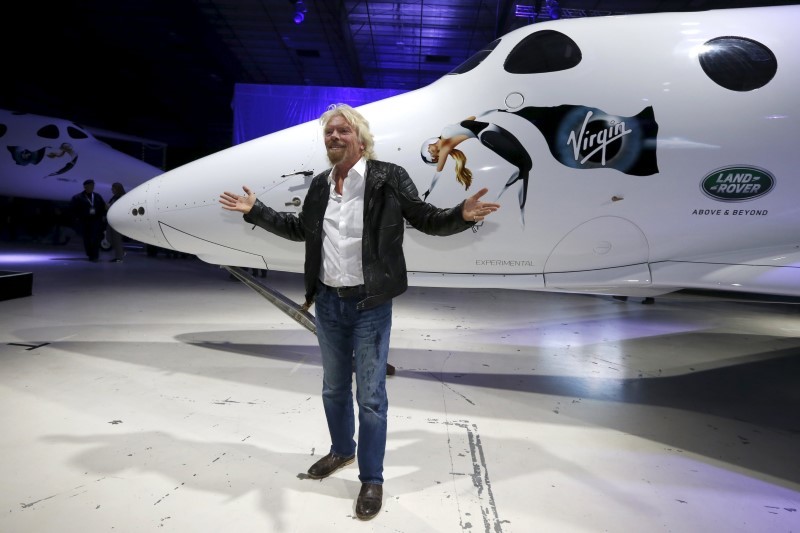By Irene Klotz
MOJAVE, Calif. (Reuters) – Richard Branson’s Virgin Galactic venture unveiled its new passenger spacecraft on Friday, nearly 16 months after a fatal accident destroyed its sister ship during a test flight over California’s Mojave Desert.
The rollout of the gleaming craft, dubbed Virgin Space Ship Unity, marks Branson’s return to a race among rival billionaire entrepreneurs to develop a vehicle that can take thrill-seekers, researchers and commercial customers on short hops into space.
The ship was painted bright white on its front section, fading to gray and black toward the tail. The tail itself was emblazoned with a blue image of a peering eye belonging to famed British physicist and Virgin Galactic supporter Stephen Hawking.
In a ceremony at the Mojave Air and Space Port, about 100 miles (160 km) north of Los Angeles, Branson’s 1-year-old granddaughter christened the ship with a bottle of milk.
“It’s almost too good to be true,” Branson said. “When I saw it for the first time, it brought an immediate lump to my throat and tears to my eyes. It was a completely overwhelming moment.”
From outward appearances, the spacecraft is nearly identical to the one lost on Oct. 31, 2014. The accident was blamed on pilot error and oversights by Northrop Gumman Corp’s Scaled Composites division, which designed, built and tested the vehicle, known as SpaceShipTwo.
Virgin Galactic’s own manufacturing arm, The Spaceship Company, already was well into construction of the successor ship of the fleet when the accident occurred.
The biggest difference between the two vehicles is the addition of a pin to prevent a pilot from unlocking the ship’s rotating tail section too soon before descent, which is what triggered the breakup of the first spaceship, said Galactic Chief Executive George Whitesides.
The two-pilot, six-passenger spaceship is designed to reach altitudes of 62 miles (100 km) above the planet, providing a few minutes of weightlessness and a view out the window of Earth set against the blackness of space. Nearly 700 people have signed up for rides, which cost $250,000 each.
Other changes include a device to prevent pilots from releasing the ship’s landing gear too early and a variety of switch changes to make them more distinct.
“We learned a lot from the accident, and we made a lot of changes,” said Mike Moses, a former NASA shuttle manager who now oversees spaceflight operations for Galactic.
Friday’s unveiling set the stage for the new ship’s first round of test flights. Whitesides said he expects to rapidly repeat milestones the first craft achieved, then incrementally test the new ship at higher speeds and altitudes. The first spaceship had not yet traveled beyond the atmosphere.
“All the math, simulations and analysis says this vehicle should be nice and stable and behave itself, but we need to go prove that,” Moses said.
Virgin Galactic is among a handful of companies, including Elon Musk’s SpaceX, Jeff Bezos’ Blue Origin, Paul Allen’s Stratolaunch Systems and Boeing, planning to fly people in space.
Building a vehicle that can safely carry humans to the weightless heights beyond Earth’s upper atmosphere is a feat so far achieved only by NASA, Russia, China and Scaled Composites, which designed and flew Virgin Galactic’s prototype craft, SpaceShipOne.
It was SpaceShipOne that made three suborbital hops in 2004 to win the $10 million Ansari XPrize.
(Reporting by Irene Klotz; Editing by Steve Gorman and Tom Brown)
























